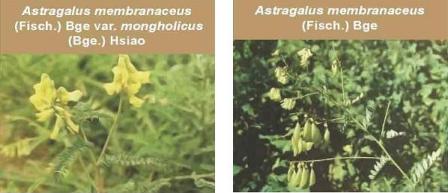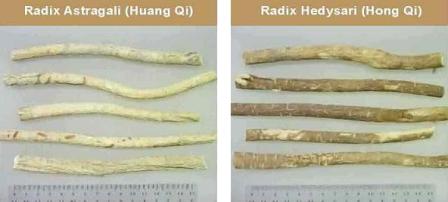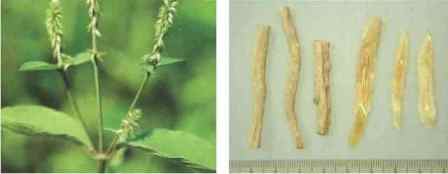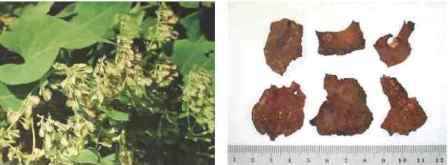Right Herbs - The Correct and Most Suitable Medicinal Herbs
Right Herbs
The Correct & Most Suitable Medicinal Herbs
Overview
Authenticating the correct species of medicinal herbs is the primary factor in establishing TCM quality control. It is also an important foundation in the modernization of Traditional Chinese Medicine. Chinese medicinal herbs are derived from natural plants, different species may share the same or similar name, which very often leads to misuse of incorrect species. Using an incorrect species will affect the efficacy of the treatment. However, in some cases, the misuse of herbs may result in serious side effects.
In general TCM herbs trading markets, there are many medicinal herbs often misused or substituted with other species, including Radix Pulsatillae (Bai Tou Weng), Radix Stephaniae tetrandrae (Fen Fang Ji), Cortex Acanthopanacis gracilistyli (Wu Jia Pi), Semen Astragali complanati (Sha Yuan Zi), Herba Polygoni avicularis (Bian Xu), Radix Achyranthis bindentatae (Huai Niu Xi), Flos Buddlejae (Mi Meng Hua), Rhizoma Arisaematis praeparata (Tian Nan Xing), Herba Lycopi (Ze Lan), Herba Siegesbeckiae (Xi Qian Cao), Rhizoma Dryopteris crassirhizomae (Guan Zhon), Semen Vaccariae (Wang Bu Liu Xing), Rhizoma Drynariae (Gu Sui Bu), Fructus Malvae (Dong Kui Zi), Herba Patriniae (Bai Jiang Cao), Rhizoma Anemones altaicae (Jui Jie Chang Pu), Radix Polygoni multiflori (He Shou Wu), Caulis Akebiae (Mu Tong), Radix Astragali (Huang Qi), Radix Aucklandiae (Mu Xiang), Semen Sesami (Hu Ma Ren), Radix Isatidis (Ban Lan Gen), Herba Taxilli (Sang Ji Sheng), Fructus Schisandrae chinensis (Wu Wei Zi), Radix Linderae (Wu Yao), Radix Aconiti lateralis praeparata (Pao Fu Zi)…etc.
In the Pharmacopoeia of People’s Republic of China (CP) and the Pharmacopoeia of Japan (JP), there are some medicinal herbs with two or more than two species recorded. Although they are all authentic herbs, yet their active constituents content and pharmacological actions are quite different sometimes. Therefore, taking both active constituents of the herb species and pharmacological functions into consideration to select the best suitable herbs from authentic species is also critical in ensuring the best TCM herbal extract quality prior to the manufacturing process. Once the best herb species is identified and selected for production, it must be used consistently in each batch production to ensure product consistency.
The following are the herbs species recorded in the pharmacopoeias and commonly used, but may not be the most suitable herbs: Herba Ephedrae (Ma Huang), Radix Puerariae (Ge Gen), Semen Armenicae amarum (Xing Ren), Semen Persicae (Tao Ren), Herba Dendrobii (Shi Hu), Radix Rehmanniae (Sheng Di Huang), Radix Rehmanniae praeparata (Shu Di Huang), Caulis Clematidis armandii (Chuan Mu Tong), Radix Gentianae stramineae (Qin Jiao), Rhizoma Dioscoreae hypoglaucae (Bi Xie), Herba Cistanches (Rou Cong Rong), and Radix Asari (Xi Xin).
We will provide detailed assessment of Radix Astragali (Huang Qi), Radix Achyranthis bidentatae (Huai Niu Xi), Radix Polygoni multiflori (He Shou Wu) in the following chapters first.
Botanical Name:Astragalus membranaceus (Fisch.) Bge var. mongholicus (Bge.) Hsiao
Chinese Name:Huang Qi (黃耆)
English Name:Astragalus, milk vetch, sweet vetch root
Herb Source:From Leguminosae plant. The dried root of Astragalus membranaceus (Fisch.) Bge var. mongholicus (Bge.) Hsiao. According to CP & JP, Astragalus membranaceus (Fisch.) Bge can be used as well.
The Most Commonly Used Huang Qi
According to CP & JP, both “Mo Jia Huang Qi” – Astragalus membranaceus (Fisch.) Bge. and “Meng Gu Huang Qi” – Astragalus membranaceus (Fisch.) Bge. var. mongholicus (Bge.) Hsiao are both recorded and both can be used as Huang Qi. Even though both herbs can be used, but in order to maintain batch-to-batch consistency in manufacturing of TCM formulas, it is necessary to consistently using the same herb only. Changing the herbs randomly will affect the product efficacy and consistency. Meng Gu Huang Qi is the most commonly and traditionally used in TCM formulas.
Commonly Misused Herb – Hong Qi
Radix Hedysari (Hong Qi) is the dried root of Hedysarum polybotrys Hand.- Mazz. It is also called “Jing Qi”, and is commonly used in local folk medicines.
Radix Hedysari (Hong Qi) has different medicinal effect from Radix Astragali (Huang Qi) according to CP. Due to their similar names in Chinese, Hong Qi is often misused for Huang Qi. Although they are of the same botanical family – Leguminosae, but they are of different genus and species. According to CP, only Astragalus membranaceus (Fisch.) Bge. var. mongholicus (Bge.) Hsiao or Astragalus membranaceus (Fisch.) Bge. can be used as “Huang Qi” in TCM formulas.
The exterior appearance of Huang Qi and Hong Qi is quite different: the bark of Huang Qi is light yellowish brown to dark brown, whereas the bark of Hong Qi is reddish brown. In TCM classic formulas, Hong Qi is seldom mentioned or used. According to scientific researches, Huang Qi and Hong Qi have different medicinal effects. Therefore, Radix Hedysari (Hong Qi) should not be used to substitute for Radix Astragali (Huang Qi).

Plants and Raw Herb Materials Description
Cylindrical, upper part relatively thick, very few branches, 20-60 cm in length, 1-3 cm in diameter. Outside is light yellow brown or dark brown color, have obvious longitudinal furrows and wrinkles. It is hard and tenacious, fracture side is highly fibrous and little powdery, the bark is cream to pale yellow color, wood part is light yellow with radiate striations and fissures, the center part of old root occasionally rotted-wood-shaped, dark brown color or hollowed. Unique aroma, taste slightly sweet, the herb has bean taste if chewed.
Cylindrical shape with very few branches, 10-50 cm in length, 0.8-2 cm in diameter. Outside is reddish-brown, tinged with greyish, with longitudinal wrinkles, transversely elongated protrusions and a few rootlet scars, outer layer easily stripped off, the exposed layer yellowish. Texture hard and tough, uneasy to break. Fracture part is fibrous, light and starchy. The bark is light brown color, formed cambium ring with brown color. Aroma is weak and unique, taste is a little sweet.

【Histological Identification】for members only
【Cultivation Site & Conditions】for members only
【Functions & Indications】for members only
【Active Constituents】for members only
【HPLC Analysis】for members only
【Commonly Misused & Substitute Herbs】for members only
Radix Achyranthis bidentatae (Huai Niu Xi)
Botanical Name:Achyranthes bidentata Bl.
Chinese Name:Huai Niu Xi (懷牛膝)
English Name:Achyranthes Root
Herb Source:The dried root of Achyranthes bidentata Bl. (Amaranthaceae Family)
Plants and Raw Herbs Materials Description
Slender cylindrical, straight or slightly curved, 15-50 cm in length, 0.4-1 cm in diameter. Externally grayish-yellow or pale brown, with slightly twisted and fine longitudinal wrinkles, transverse lenticellike protrudings and sparse rootlet scars. Texture hard and fragile, easily broken, softened when moistened, fracture even, pale brown, slightly horny and oily. Xylem of vascular bundles in the center relatively large, yellowish-white, the outside scattered with many spotted vascular bundles arranged in 2-4 whorls. Aroma, slight; taste, slightly sweet, somewhat bitter and astringent.

【Histological Identification】for members only
【Cultivation Site & Conditions】for members only
【Functions & Indications】for members only
【Active Constituents】for members only
【HPLC Analysis】for members only
【Commonly Misused & Substitute Herbs】for members only
Radix Polygoni multiflori (He Shou Wu)
Botanical Name:Polygonum multiflorum Thunb.
Chinese Name:He Shou Wu (何首烏)
English Name:Fleece-flower root
Herb Source:The dried root of Polygonum multiflorum Thunb (Polygonaceae Family).
Plants and Raw Herbs Materials Description
Mass or irregular fusiform, 5-15 cm in length, 4-10 cm in diameter. Exterior is reddish-brown, shrunken and uneven, shallowly grooved, with transverse elongated lenticel-like protrusions and fine rootlet scars. Texture heavy, compact, uneasily broken, fracture pale yellowish-brown or reddishbrown, starchy, bark exhibiting 4-11 subrounded rings of abnormal vascular bundles, forming brocaded patterns, wood in central part relatively large, some having a woody core. Aroma, slight; taste, bitter, sweet, and astringent.

【Histological Identification】for members only
【Cultivation Site & Conditions】for members only
【Functions & Indications】for members only
【Active Constituents】for members only
【HPLC Analysis】for members only
【Commonly Misused & Substitute Herbs】for members only